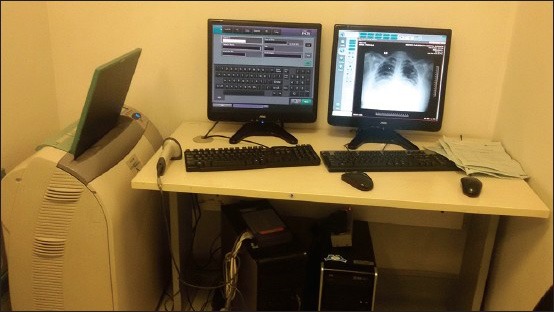Sir,
In medical imaging, electronic picture archiving and communication systems (PACS) have been developed in an attempt to provide economical storage, rapid retrieval of images, access to images acquired with multiple modalities, and simultaneous access at multiple sites. Electronic images and reports are transmitted digitally through PACS; this eliminates the need to manually file, retrieve, or transport film jackets. We are using this technology quite successfully in our hospital, especially in Intensive Care Units (ICU).
History of Picture Archiving and Communication Systems
The principles of PACS were first discussed at meetings of radiologists in 1982. Cardiovascular radiologist Duerinckx and Pisa first used the term in 1981.[1] Harold glass, a medical physicist working in London in the early 1990s secured UK Government funding and managed the project over many years, which transformed Hammersmith Hospital in London as the first filmless hospital in the United Kingdom.[2] The first large-scale PACS installation was in 1982 at the University of Kansas, Kansas city. Nowadays, it has become an important component for the functioning of any modern hospital.
Picture Archiving and Communication Systems consists of four major components:
Imaging modalities such as computed tomography (CT) and magnetic resonance imaging (MRI).
A secured network for the transmission of patient information.
Workstations for interpreting and reviewing images.
Archives for the storage and retrieval of images and reports.
Combined with available and emerging web technology, PACS has the ability to deliver timely and efficient access to images, interpretations, and related data. PACS breaks down the physical and time barriers associated with traditional film-based image retrieval, distribution, and display. Moreover, it can handle images from various medical imaging instruments, including ultrasound, MR, positron emission tomography, CT, etc. The universal format for PACS image storage and transfer is Digital Imaging and Communications in Medicine.
Clinical Benefits of Picture Archiving and Communication Systems
Increased availability of images.
Increased processing, no lost film, multiple copies of the same image can be generated.
Image manipulation to overcome under or over exposure.
Increased speed and quality of reporting.
Transmission of the hospital to other hospitals.
Digitizing old films.
Reliability.
Ease of use.
Cost Analysis
We performed a small study at our institution. There were about 80 chest radiographs done in our cardiac ICU daily. Therefore, in a month about 2400 radiographs were done. Cost of radiograph if done in a conventional way is as follows:
Cost of one X-ray film = Rs. 40/film.
Cost per day per ICU = 40 × 80= Rs. 3200.
Cost per month per ICU = 3200 × 30= Rs. 96,000.
Cost per bed per month = 96000/44= Rs. 2182.
Cost of radiograph if done using PACS is as follows:
Cost of X-ray film — NIL.
Cost of PACS and other hardware — Rs. 20 million (1 time).
This is a cost in one cardiac surgical ICU only. There are five ICUs and one coronary care unit in our hospital and each patient is having one radiograph done daily. Moreover, there are about 700 beds in the wards as well. Each patient in ward undergoes some kind of radiological procedure daily. Therefore, by using PACS we can save about 2100 rupees/bed/month in ICU. There are 300 ICU bed in our hospital; thus, we can save about rupees 7 lakhs/month/month in ICUs for radiology films.
PACS has a number of advantages over conventional films such as time saving, reliability of the system, space saving, economy in consumables and personnel, efficiency of data management, accessibility of images and teaching benefits.[3] The PACS used in our ICU is occupying very little space that consists of a processing unit and a viewing screen [Figure 1]. The disadvantages of PACS are: Its cost, the need for specialized personnel for its installation and maintenance, training of users, the possibility of breakdown, and data security issues. PACS has been used successfully in our cardiac ICU. We have shown the benefits in terms of time and cost saving. If it is used all over the hospital then substantial cost and manpower saving can be done. It has been used over the years in various hospitals in Europe and Japan.[4,5] The other advantage of PACS is accessibility from any computer in the hospital or handheld devices, which are password protected.
Figure 1.

Picture archiving and communication systems workstation
In conclusion, PACS is an important tool for digitizing, archiving and transmission of the image in a cost-effective way. It is expected to make the departments more efficient, reduce operating costs, and improve communication among physicians. Its use should be promoted in every tertiary care and high volume centers.
References
- 1.Duerinckx AJ, Pisa EJ. Filmless picture archiving and communication system (PACS) in diagnostic radiology. Proc SPIE. 1982;318:9–18. Reprinted in IEEE Computer Society Proceedings of PACS’82, Order No. 388. [Google Scholar]
- 2.Bryan S, Weatherburn GC, Watkins JR, Buxton MJ. The benefits of hospital-wide picture archiving and communication systems: A survey of clinical users of radiology services. Br J Radiol. 1999;72:469–78. doi: 10.1259/bjr.72.857.10505012. [DOI] [PubMed] [Google Scholar]
- 3.Hains IM, Georgiou A, Westbrook JI. The impact of PACS on clinician work practices in the intensive care unit: A systematic review of the literature. J Am Med Inform Assoc. 2012;19:506–13. doi: 10.1136/amiajnl-2011-000422. [DOI] [PMC free article] [PubMed] [Google Scholar]
- 4.Terae S, Miyasaka K, Fujita N, Shirato H. A hospital-wide PACS: 7 year experience and new development. Comput Methods Programs Biomed. 1998;57:5–12. doi: 10.1016/s0169-2607(98)00038-8. [DOI] [PubMed] [Google Scholar]
- 5.Strickland NH. The filmless hospital: 3-year experience at the Hammersmith Hospital, London. Bull Acad Natl Med. 1999;183:1615–23. [PubMed] [Google Scholar]


